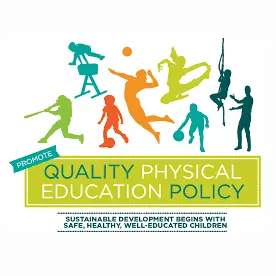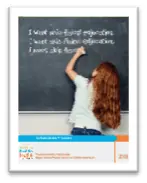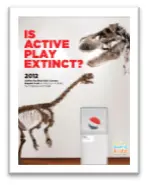At the beginning of the academic year, I express to my pre-service HPE teachers…

I don’t think that teachers of other subject disciplines such as math, science, music have to not only learn about “how to teach” but to also think about becoming an advocate for “what they teach”. I believe this holds true for Health and Physical Education teachers everywhere.
Over the past ten years, teaching pre-service HPE teachers at OISE (Ontario Institute for Studies in Education), at the University of Toronto, I have shared the Active Healthy Kids Canada Physical Activity Report Card that examines how families, peers, schools, communities and built environments are contributing or not contributing to the overall physical activity in children and youth.
The report card has been used as a tool for public awareness, advocacy strategies, research and practice and policy change to get kids more active. Despite its efforts over the years, the message still remains that we are failing to meet the target of 60 minutes of moderate-to-vigorous physical activity (MVPA) per day for proper growth and development for children and youth in Canada. In fact, only 9% of children between the ages of 5-17 years old get the 60 minutes of “heart-pumping” physical activity they need daily as reported in the 2015 report card.
The faces of the report cards over the past decade have shared powerful images that capture the very essence of key issues that have contributed to this state of inactivity or can mobilize systemic change that physical activity and quality physical education matter:

Ensuring quality PE in the elementary years to providean active start (2010 AHKC Report Card)

Making the connection between physical activity and academic learning that exercise increases student attentiveness and readiness to learn (2009 AHKC Report Card)

Bringing back more opportunities for students to engage in unstructered, creative play (2012 AHKC Report Card)

Unplugging our kids to have less screen time (2008 AHKC Report Card)

Creating more opportunities for active transportation to combat sedentary behavioiurs (2013 AHKC Report Card)
It is no secret that sedentary lifestyles are linked to health concerns of non-communicable diseases, that “sitting has become the new smoking”, and that…

This image is found on Thompson Educational Publishing’s website, another powerful image that captures the very essence of the possible effects on our kids growing up digital in replace of play.
So, now what?
First, we need to invest in more quality Physical Education for change to happen. Once, a wise professor of mine told me, “Three things need to be in place for systemic change”…
- Soung Pedagogy: We do have current ways of thinking about how to teach HPE with curriculum models such as TGFU (Teaching Games for Understanding), TPSR (Hellison’s model on Teaching Personal and Social Responsibility through HPE) that contribute to an inclusive, student-centred learning space for HPE to come alive. I have recent blogs on these pedagogies you can access.
- Effective Resources: In Ontario we have the long awaited 2015 Health and Physical Education Curriculum that reflects the needs of students in the 21st century. We have also have companies like Thompson Educational Publishing and Gopher that support the delivery of quality PE with evidence based resources.
- Supportive Beliefs and Values: This is the biggest barrier to ensuring quality PE is implemented with the same importance and percentage of curriculum time as other subject.
So, I continue to share my voice as an advocate for quality PE with my pre-service teachers, in the hope that, they will find their voice to be a champion for quality PE in their schools and communities.
Next, we need to use advocacy tools, such as the recent UNESCO Quality PE Guidelines, released on January 29, 2015, which emphasize why we need to invest in quality PE.
Also, Dr. Dean Dudley, from Macquire University- Australia, led a webinar on the Thompson Educational Publishing Huddle using the UNESCO policy as a springboard for policy makers and PE teachers to invest in quality PE for all. Dr. Dudley, defines quality PE to be “a planned, progressive, inclusive learning experience that forms part of the curriculum across all the levels, primary to secondary for students throughout their school careers … a one size fits all is failing our students”.
Heath benefits of investing in quality PE such as:
- More physically active and literate children and youth
- Reduces risks of non-communicable diseases such as heart disease, stroke, diabetes, and cancer
- Less likely to smoke, become pregnant or engage in risky sexual behaviours and use drugs
Inclusivity….one of the major themes for quality PE resonates with me. Dudley suggests that PE can be a platform to overcome stereotypes and stigma towards mental health, disabled, minority groups, and gender as an example. Empower girls to be more active. Typical roles around gender should be challenged. Move away from splitting games into boys and girls as a default and ensure that male and female achievement in PE is treated as equal. Engage marginalized groups as PE can break down language and ethnic barriers and encourage intercultural dialogue and understanding. Include non-traditional North American games in your program such as Tchoukball, Cricket, Danish Longball and other games of the world.
The UNESO Policy also emphasizes that investing in quality PE can increase physical literacy, civic engagement, and academic achievement. Recently, there has been a lot of attention on physical activity and academic achievement and Dr. Dudley’s expresses that we need to change the conversation to what else can quality PE do?
Quality PE as highlighted by Dr. Dudley:
- Has a great capacity to improve social skills and reduce student anxiety at school in their social groups
- Increases motivation to attend school and motivation to learn – kids are more likely to stay in school if they feel a sense of belonging and connectedness
- Uses more of a play-based learning framework than any other subject which helps students be creative, problem solve and build behaviour and social dynamics that empower them to learn more effectively
So, how we can make Quality PE happen?
- Promote high levels of moderate to vigorous physical activity during PE time
- Use student-centred, differentiated active learning strategies to improve students’ perceived physical competence – “help kids feel they have the capacity to have a “go” and be successful” states Dudley.
- Develop a broad range of movement skills, knowledge of concepts and game strategies to increase competence and physical literacy
- Promote and assess social and personal skills e.g., responsibility through inclusive PE
UNESCO recommends 120 minutes of PE curriculum per week with an increase up to 180 minutes of PE curriculum per week in secondary schools. PE time is independent of health education time.
Last thought from the UNESO Policy to ponder… A gap remains between policy and practice despite all the benefits. Research shows that 97% of countries globally have compulsory PE. Yet, in 54% of countries, PE has a perceived lower status than other subjects. Only 53% of elementary schools have qualified trained PE teachers.
What are you doing or what advocacy tools do you use in your school communities to change peoples’ believes and values that quality PE matters?
Check out the recent 2015 ParticipACTION Report Card on Physical Activity on Children and Youth (formerly the Active Healthy Kids Canada Report Card) that is, for the first time, taking a stand on play in nature and outdoors with its risks for healthy child development.




